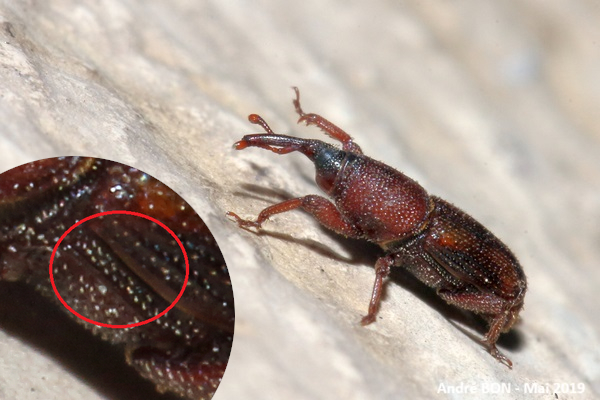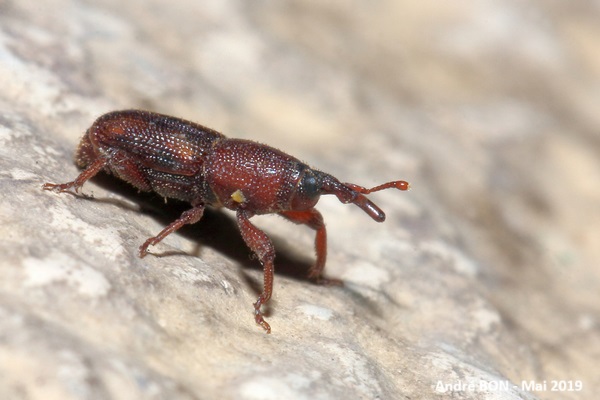

| Rice Weevil (Sitophilus oryzae (Linnaeus, 1763)) |


|
|
Scientific name: Sitophilus oryzae (Linnaeus, 1763) Common name: Rice Weevil Other names: Lesser Grain Weevil French name: Charançon du riz, Charançon des céréales. Order: Coleoptera Family: Curculionidae Wingspan : 3-4.6 mm. Biotope: Granaries and silos where cereal seeds are stored. Geographic area: The Rice Weevil has been introduced to many countries by the transport of grain. Some publications cite an origin in India but I have read that this is not certain. Observation period : All year round. |
The Rice Weevil has an elongated, reddish-brown body. The rostrum is straight and 5 times longer than the short head. The elbowed antennae are pointed forward when walking. They consist of 8 segments including the scape at the base and a club-like segment at the tip. The square-shaped pronotum is densely punctuated with rounded points. The elytra bear densely punctuated streaks and are marked with 4 orange-brown spots that are not always very visible. Females bore holes into the grains to lay eggs. The larvae devour the inside of these grains. The Wheat Weevil (Sitophilus granarius) and the Tamarind Weevil (Sitophilus linearis) do not have the 4-spot orange-brown pattern on the elytra. It is more complicated with the Maize Weevil (Sitophilus zeamais) which is very similar although slightly larger in size. Due to variations between individuals this size criterion can only be used by precisely measuring an entire group of individuals in a population and basing the identification on the measured average. Sitophilus oryzae has a smooth median line on the pronotum that Sitophilus zeamais does not have. The metepisternum (plate located between the middle leg and the hind leg, just under the elytron) has 2 rows of well-aligned punctuations in Sitophilus oryzae and 3 more disordered rows in Sitophilus zeamais. |
| [To know more about the Rice Weevil] [Next picture] [Top] |

|
The orange-brown markings on the elytra are clearly visible, I did not measure the exact size and it is an isolated individual. It is therefore either a Rice Weevil (Sitophilus oryzae) or a Maize Weevil (Sitophilus zeamais). The side view allows you to see the metepisternum which has two rows of well-aligned punctuations. So I think we have here the Rice Weevil. |
| [To know more about the Rice Weevil] [Previous picture] [Top] |

|
I still have a bit of trouble with photographing very small subjects. I need to have a fixed support (the wall here) to avoid motion blur and to focus precisely. As a result, I only have profile photos and I can't see if the pronotum has a smooth median line. |